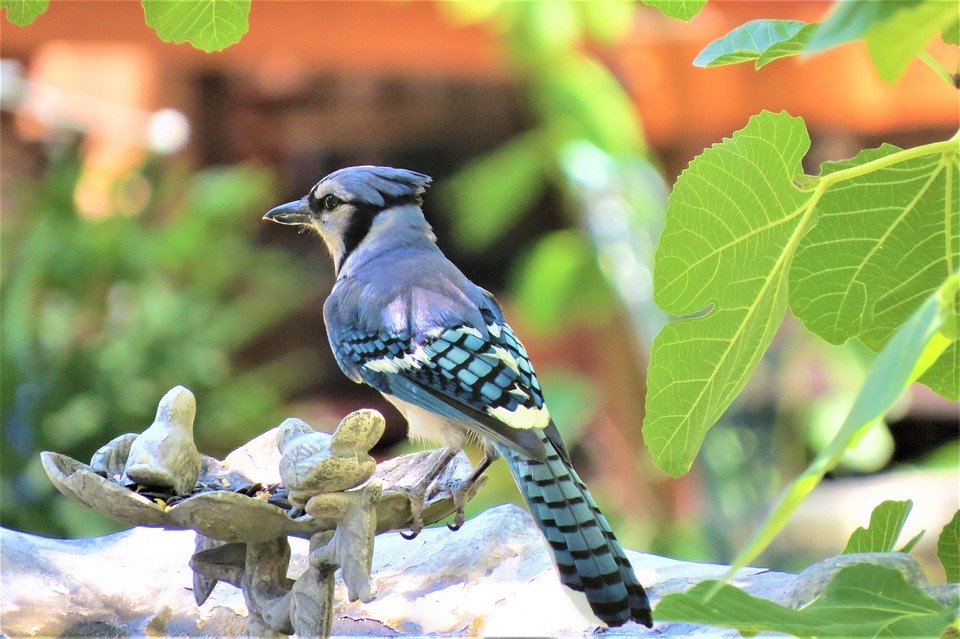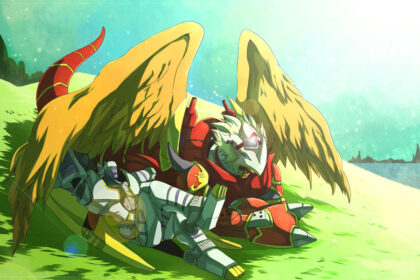Blue jays are songbirds that belong to the Corvidae family. They’re native to the eastern United States forests. They inhabit deciduous, coniferous and mixed forests throughout eastern and central United States, and southern Canada. Take a look below for 27 more fun and interesting facts about blue jays.
1. Captive blue jays can live up to 26 years while wild blue jays live up to 17 years.
2. Blue jays can grow up to between 22 and 30 centimeters, or 9 and 20 inches, from bill to tail, with a wingspan of between 34 and 43 centimeters, or 13 and 17 inches. They can weigh between 70 and 100 grams, or 2.5 to 3.5 ounces.
3. They have a pronounced crest on their head, which is called a crown of feathers. This crown can be raised or lowered depending on their mood.
4. When the crown is raised, it makes a prominent peak and it means that the blue jay is excited, surprised or aggressive. When it’s bristled out in all directions, it means that the jay is frightened. When the crown is flat, then the jay is relaxed.
5. It has a lavender blue plumage with a white face and an off white underbelly. They have black collared necks and black streaks that go down the sides of their heads. Their bill, legs and eyes are also black. Their main wing and tail feathers are a combination of black, blue and white.
6. Male and female blue jays are almost exactly alike, except the male is slightly larger.
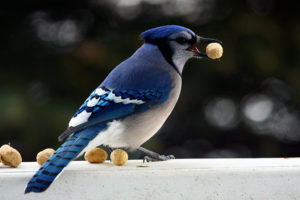
7. Their coloration is the result of light interference due to the internal structure of the feathers. If the feathers are crushed, the blue color goes away as the structure is destroyed.
8. The molting of the feathers on their body and wings lasts about 6 between, between June and July. During this process, their skin is covered with a thin coating.
9. They’re omnivores, which means that they have a plant and animal based diet. Their diet consists of fruits, berrie, acorns, seeds, nuts, insects, mice, frogs, eggs and nestlings.
10. When they eat nuts, they’re known to hold it with their feet while they cracks it open with their bill.
11. They’re known for burying food so that they can eat it later. Some seeds and nuts are never recovered and grow into trees and other plants, which means that blue jays are an important part of the ecosystem.
12. Blue jays are aggressive and territorial. They will attack intruders and predators.
13. Compared to other birds, they’re relatively slow fliers. They fly at speeds of between 32 and 40 kilometers per hour, or 20 and 25 miles per hour. Due to their slow speed, they’re easy prey for hawks and owls.
14. They’re able to make a wide variety of sounds. The most common call is a hash, jerring jay-jay, which is where it gets its name.
15. Blue jays can also mimic the sound of hawks, which it uses to inform other blue jays that there’s a hawk present or to deceive other species into believing a hawk is near.
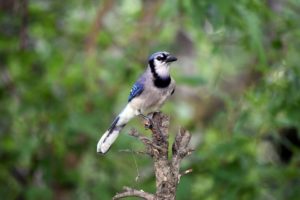
16. They’re social birds and can normally be found in pairs, in family groups or in small flocks.
17. They’re partially migratory birds and they will migrate during the daytime, joining larger flocks for the journey. However, some blue jays will stay throughout the winter, while some individual jays migrate south one year, then stay north the next winter.
18. They form long lasting, monogamous pair bonds that usually last until one of the pair dies.
19. Their mating season starts in March, peaks in April to May, and sometimes extends into July.
20. Both the male and female blue jays will help build the nest. The male blue jay will stay with the female to feed her throughout courtship and to help with the incubation of the eggs.
21. The female blue jay will lay between 3 and 6 eggs and the eggs will be incubated for 16 to 18 days.
22. Blue jays will aggressively defend their nests against predators. Both the male and female blue jays will attack and chase hawks, falcons, raccoons, cats, snakes and squirrels away from their nests.
23. When the offspring fledges, the family will travel and forage together until early fall. In early fall, the offspring will disperse to avoid competition for food during the winter.
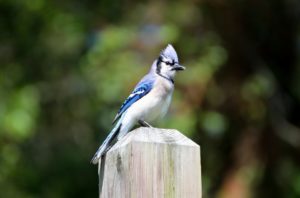
24. Their populations are on the rise and they’re very common to see in their habitat.
25. In old African American folklore, the blue jay was seen as a servant of the Devil. The people that believed in this often stated that he was not encountered on a Friday as he was fetching sticks down to Hell; furthermore, he was so happy and chirpy on a Saturday as he was relieved to return from Hell.
26. The blue jay was adopted as the team symbol of the Toronto Blue Jays Major League Baseball team.
27. The blue jay is featured in Mark Twain’s “A Tramp Abroad,” Chapter 3 “Baker’s Blue-Jay Yarn.”

